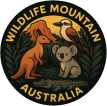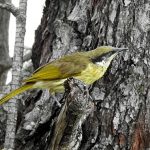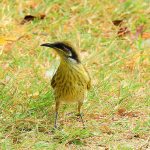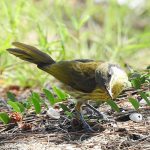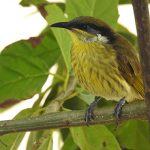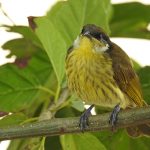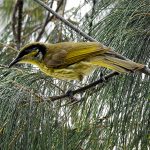VARIED HONEYEATER
The Varied Honeyeater is a fascinating bird native to Australia, particularly found in the northern regions like Queensland and extending to Papua New Guinea.
It is a medium-sized bird, measuring around 20 to 25 centimetres in length. It sports a vibrant plumage, predominantly olive-brown on its back and wings, with a paler, streaked breast and belly. Its face is adorned with a striking yellow patch around the eyes, which adds to its distinctive appearance. The honeyeater’s slender, curved bill is perfectly adapted for sipping nectar from flowers.
This bird thrives in coastal and mangrove habitats, often seen flitting among the trees in search of food. It is most commonly found in Queensland’s Cape York Peninsula where the lush environment provides ample resources for its survival.
The Varied Honeyeater is known for its lively and melodious calls. Its vocalisations are a series of rich, varied notes that can be heard echoing through its habitat. These calls are not only a delight to the ears but also serve important roles in communication and territory defence.
As its name suggests, the Varied Honeyeater primarily feeds on nectar, which it extracts from flowers using its specialised bill. By feeding on nectar, Varied Honeyeaters play a crucial role in pollination, helping to sustain the ecosystems they inhabit. However, it is not solely dependent on nectar; it also consumes insects and fruit, making it an adaptable feeder within its environment. These honeyeaters are often seen in small groups, especially during feeding, which enhance their social interactions and foraging efficiency.
The breeding season for the Varied Honeyeater generally occurs from August to January. During this time, the birds build cup-shaped nests, often in dense foliage or mangroves, to lay their eggs. Typically, the female incubates the eggs, while both parents participate in feeding the chicks once they hatch.
While specific data on the lifespan of the Varied Honeyeater is limited, many honeyeater species can live for several years in the wild, provided they have access to ample food and a safe habitat.
The Varied Honeyeater is currently listed as Least Concern on the IUCN Red List. This status indicates that the species is relatively stable, though ongoing habitat destruction and climate change pose potential threats that could impact its populations in the future.
The Varied Honeyeater is a remarkable example of Australia’s diverse avian life. Through understanding and appreciation, we can foster a deeper connection with these vibrant creatures and the ecosystems they inhabit, encouraging efforts to preserve their natural habitats for future generations.
